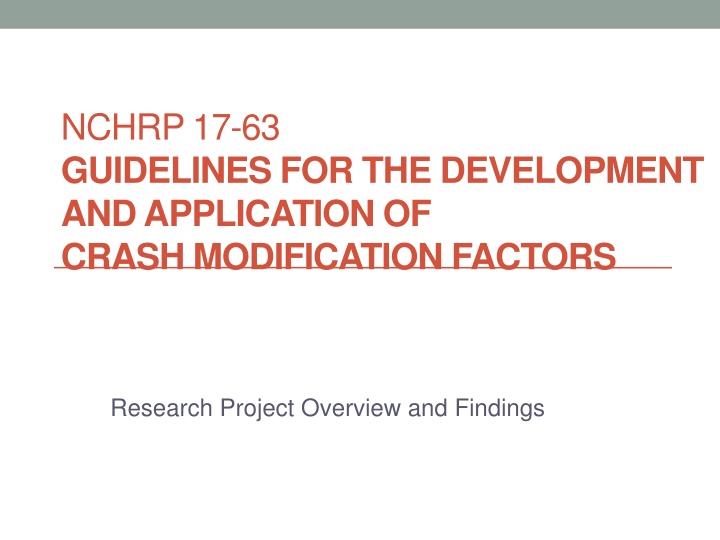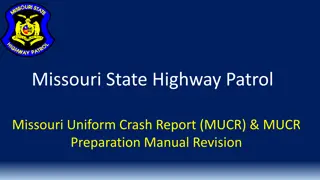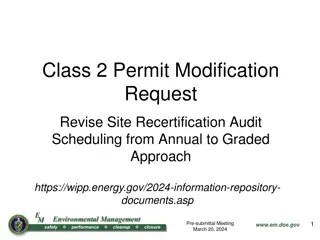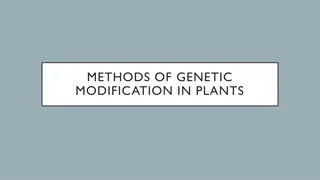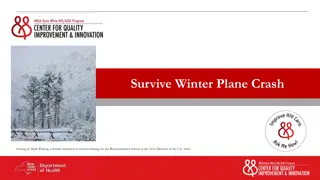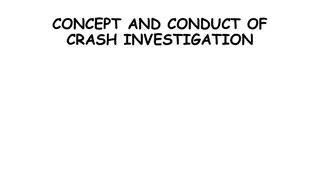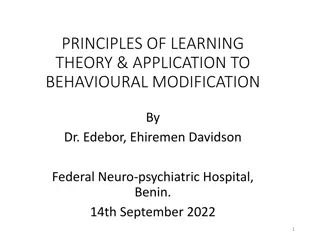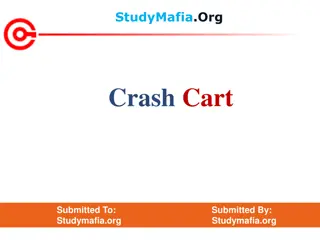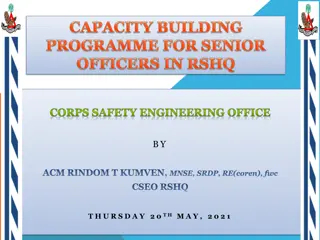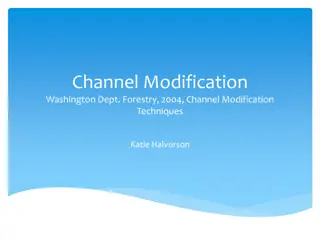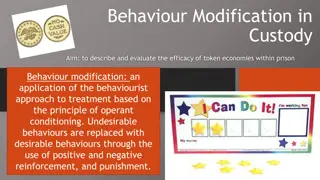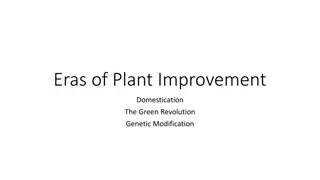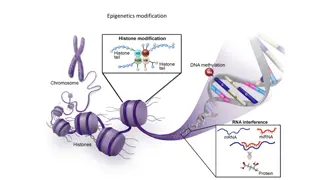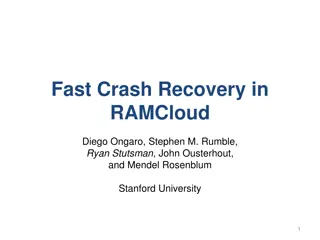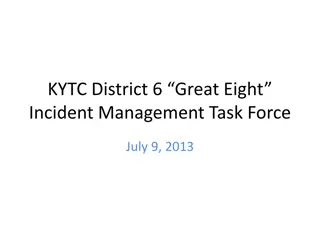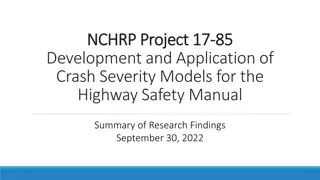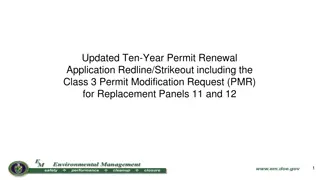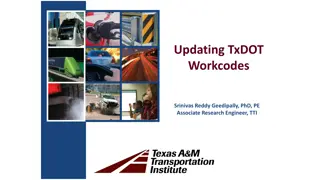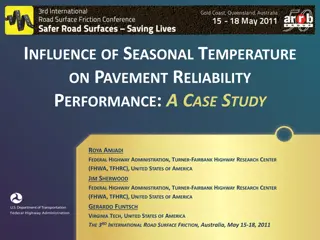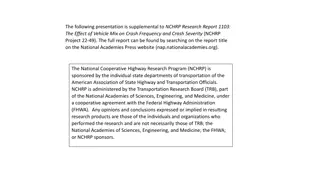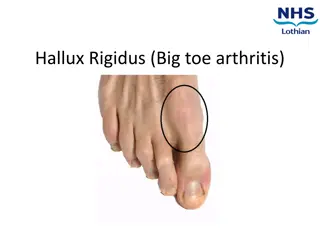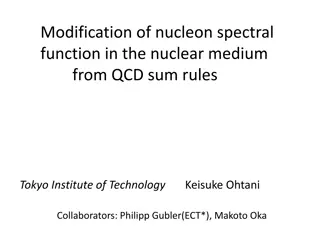GUIDELINES FOR THE DEVELOPMENT AND APPLICATION OF CRASH MODIFICATION FACTORS
These guidelines address the development and application of Crash Modification Factors (CMFs) for assessing safety treatments at various sites. The research project focuses on calibrating current CMFs, combining multiple treatments, and formulating future CMFs based on key site characteristics.
Download Presentation

Please find below an Image/Link to download the presentation.
The content on the website is provided AS IS for your information and personal use only. It may not be sold, licensed, or shared on other websites without obtaining consent from the author.If you encounter any issues during the download, it is possible that the publisher has removed the file from their server.
You are allowed to download the files provided on this website for personal or commercial use, subject to the condition that they are used lawfully. All files are the property of their respective owners.
The content on the website is provided AS IS for your information and personal use only. It may not be sold, licensed, or shared on other websites without obtaining consent from the author.
E N D
Presentation Transcript
NCHRP 17-63 GUIDELINES FOR THE DEVELOPMENT AND APPLICATION OF CRASH MODIFICATION FACTORS Research Project Overview and Findings
Background Crash modification factors are available for many countermeasures through the FHWA CMF Clearinghouse, HSM 1stedition, and state reports. Many agencies use CMFs to quantify expected benefits of proposed safety treatments Increased knowledge and experience with CMFs leads to several questions: Will a CMF developed under one set of conditions apply to another set of conditions (i.e., state, roadway type, etc.)? If multiple treatments are applied, how should the combined effect be estimated? How should CMFs be developed to account for differences in sites? Project 17-63 addressed these questions in three major objectives
Objective Objective 1. Develop guidelines for calibration of current CMFs to assess treatment effectiveness at sites for which key site characteristics may be different. Objective 2. Develop guidelines for how existing and future CMFs can be combined in a single location with multiple treatments. Objective 3. Develop recommended procedures for formulating and calibrating future CMFs that identify key influential site characteristics.
Guidelines on CMF Selection and Adjustment Addresses Objective 1 Audience is safety practitioners Guides user in the selection of CMFs for a site of interest Adjusts CMF for site of interest based on crash distribution
Guidelines on CMF of Combined Effect of Two Treatments Addresses Objective 2 Audience is safety practitioners Provides discussion of the issues encountered when considering combined effect Procedure guides user in calculating combined effect based on magnitude of CMFs and potential overlap Discussion on how to expand to more than two treatments (though not validated in this project)
Guideline on Developing CMFunctions Addresses Objective 3 Audience is safety researchers Provides guidelines on developing CMFunctions from observational studies Discusses key issues and how to overcome or mitigate them Demonstrated through four case studies
Research Products Procedures and guidelines provided as standalone appendices of final report Procedure for Estimating the Effect of a Proposed Treatment at a Subject Site (Appendix A) Procedure for Estimating the Combined Safety Effect of Two Treatments (Appendix B) Guidelines for Developing Crash Modification Functions (Appendix C)
Research Products General Appendix Layout: Introduction introduces the topic, provides background information, and relates it to the overall project. Procedure provides the steps of the procedure Example Applications of Procedure provides examples of the procedure or guidelines, walking through every step with realistic data Supporting Research provides documentation of the research conducted under Project 17-63 to support the development of the guidelines or procedure presented in the appendix.
Research Products Microsoft Excel CMF Regression Software supports procedures of Appendix A. Computes average CMF; disaggregates total CMFs into specific crash type or severity category CMFs; computes CMFs as function of site characteristics CMF Combination Tool supports procedures of Appendix A. Compares CMFs for statistical similarity; computes combined CMF. tools
Disclaimer The National Cooperative Highway Research Program (NCHRP) is sponsored by the individual state departments of transportation of the American Association of State Highway and Transportation Officials. NCHRP is administered by the Transportation Research Board (TRB), part of the National Academies of Sciences, Engineering, and Medicine, under a cooperative agreement with the Federal Highway Administration (FHWA). Any opinions and conclusions expressed or implied in resulting research products are those of the individuals and organizations who performed the research and are not necessarily those of TRB; the National Academies of Sciences, Engineering, and Medicine; the FHWA; or NCHRP sponsors.
